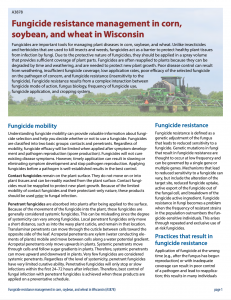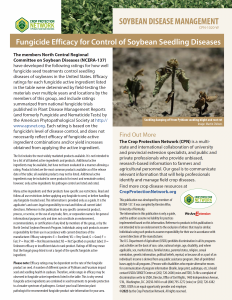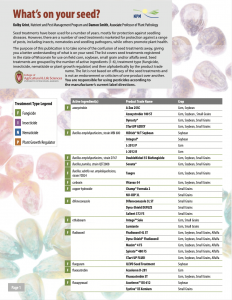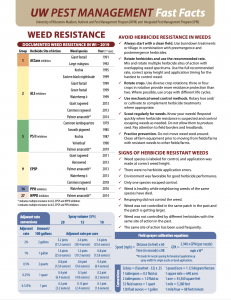Fungicides have become a major component of plant disease management plans for agronomic crops. Fungicides are applied to prevent or slow epidemics of disease caused by fungi. Unlike insecticides and herbicides, which are used to kill insects and weeds, fungicides are applied to form a barrier to protect plant organs from infection.
Performance of fungicide products can be affected by many factors including timing of application, off-label rates, poor product choice for the pathogen of concern (e.g. active ingredient is not effective against the organism), fungicide resistance, etc.
Don’t Forget The Plant Disease Triangle
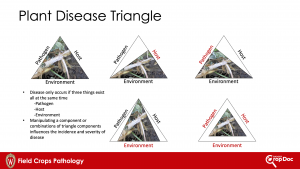
The plant disease triangle is a diagrammatic view of what it takes for a plant disease to occur. You can think about managing a plant disease by considering how to manipulate certain aspects of the triangle to shrink the center area (a.k.a. to limit plant disease).
One of the best ways to improve the efficacy of a fungicide is to use it in conjunction with other cultural practices. A great model to use when considering an integrated disease management approach is to consider the plant disease triangle. The plant disease triangle demonstrates that it takes a virulent pathogen, a susceptible host, and favorable environment occurring at the same time for the development of a plant disease. If any one of these components is missing a plant disease will not occur. Likewise, if a component of the triangle is manipulated in some way, the magnitude of a disease can be affected.
The host component can be manipulated by using plants that have genetic resistance against the pathogen of interest. Also, managing plant stress and using hybrids/varieties that are well adapted to an area equates to plants that are less likely to be predisposed to a plant disease.
Manipulating the environmental component of the triangle can be much more difficult. However, the environment immediately around a plant (microenvironment) can be changed, to a certain extent. For example, managing soil fertility can provide an environment favorable for plant growth and reduce plant disease. Changing plant population and spacing or reducing irrigation can change the microenvironment and can also reduce plant disease.
The pathogen component can be manipulated in several different ways. Excluding a pathogen from an area is an excellent way to control plant diseases. Using certified pathogen-free seed and cleaning field implements between fields could prevent the introduction of a pathogen to a non-infested field. Eradication can also be applied to pathogens. This strategy can be very difficult because it can be nearly impossible to remove all infested plants and/or soil from an area to completely rid it of a pathogen. Sanitation can be utilized by removing or burying pathogen-infested plant material. As mentioned previously, fungicides are also used to manipulate the pathogen.
Fungicides, Fungicide Mode of Action, and Fungicide Mobility
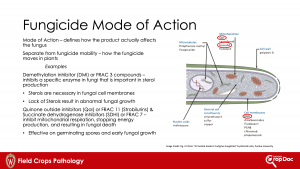
Fungicide mode of action refers to how a fungicide inhibits fungal growth. This is different from mobility which is how the fungicide enters and moves in the plant.
The word ‘fungicide’ implies that a chemical will kill a fungus. This can be misleading as many of the products used to control fungi are actually only fungistatic (meaning they simply inhibit the growth or reproduction of a fungus and are not directly toxic to the organism).
Fungicide mode of action defines how the product actually affects the fungal organism. For instance, the demethylation inhibitor (DMI) fungicide group (contains the triazoles) inhibits a specific enzyme in fungi that plays a role in sterol production. Sterols are necessary for the development of cell walls in fungi. Therefore, the application of DMIs results in abnormal fungal growth, repressed growth, and in some cases death. All fungicides within the DMI group have this same mode of action.
One of the strategies to manage fungicide resistance development is to rotate fungicide mode-of-action. Considering the example of using DMI fungicides above in a proper rotation, the crop manager must choose a fungicide that is not in the DMI group for a subsequent application. This is analogous to a pitcher in baseball. Pitchers don’t typically throw the same style of pitch each time. They rotate fastballs, with screwballs, with sliders, etc. This same approach should be adopted when developing a fungicide program.
Care should also be taken during the development process to identify products with pre-mixed active ingredients in different mode-of-action groups. For instance if a pre-mix product is chosen that contains a Fungicide Resistance Action Committee (FRAC) 3 (DMI compound) and also a FRAC 11 (strobilurin compound) then the next fungicide application should ideally be a product that does not contain either a FRAC 3 or 11 compound.

Fungicide mobility describes how the fungicide enters and moves in the plant. This is different from mode of action which describes how a fungicide inhibits fungal growth.
Fungicide mobility is separate from fungicide mode of action. By understanding mobility and mode of action and how the two work in unison to control a fungus in a crop plant, the better the disease management decision-making process can be. Fungicides have one of two types of mobility: contact or penetrant. Regardless of the mobility, fungicide products work best when applied prior to symptom development and pathogen reproduction (spore production). Applying fungicides close to the onset of an epidemic will yield the best control of diseases caused by fungi.
Contact fungicides are applied to the surface of a plant and do not move into plant tissue. They can be washed from the plant and degrade by exposure to the weather. Therefore, contact fungicides must be reapplied regularly to re-establish protection on previously treated plant organs, or applied to protect new plant growth. Contact fungicides act by forming a protective barrier against fungal invasion. Therefore, they must be applied prior to fungal infection.
Penetrant fungicides can move into plants after being applied to the surface. Due to the movement of the fungicide into the plant, these fungicides are generally considered ‘systemic’ fungicides. This can be misleading as the degree of systemicity can vary among fungicides.
Local penetrant fungicides move just short distances, such as into the waxy plant cuticle and remain in that location.
Translaminar penetrants can move through the cuticle between cells toward the opposite side of the leaf.
Acropetal penetrants are xylem-mobile (xylem elements are the water conducting vessels of plants) and move between cells along a water potential gradient. Acropetal penetrants only move upwards in plants.
Systemic penetrants move through cells and follow sugar gradients in plants. Therefore, systemic penetrants can move upward and downward in plants. Very few fungicides are considered systemic penetrants.
Regardless of the level of systemicity, penetrant fungicides have very limited ‘curative’ ability. Penetrant fungicides will only stop or slow infections within the first 24- to 72-hours after fungal penetration. Therefore, best control of fungal infections with penetrant fungicides will be achieved when these products are applied on a preventative schedule.
Fungicide Resistance in Fungi
Fungicide resistance results from genetic adjustment of the fungus, which leads to reduced sensitivity to a fungicide. Genetic mutations in fungi that result in fungicide resistance are thought to occur at low frequency and can be governed by a single gene or multiple genes.
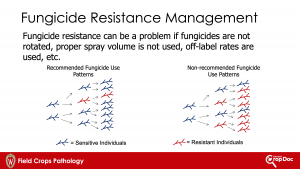
Fungicide resistance development in two populations of fungi. The population on the left has been subjected to fungicide application in a manner to reduce fungicide resistance development. While the population on the right has been subjected to repeated applications of the same fungicide.
Mechanisms that lead to reduced sensitivity to a fungicide can vary, but include a change in the target site, active export of the fungicide out of the fungal cell, breakdown of the fungicide active ingredient, and reduced fungicide uptake.
Fungicide resistance occurs when the frequency of resistant fungal strains in the population outnumbers the fungicide-sensitive individuals. This arises through repeated and exclusive use of fungicides with high-risk for fungicide resistance development.
Selection pressure can be high when repeated fungicide applications are used to control many of the foliar diseases of field crops. Risk of fungicide resistance development is low for seed treatments and soilborne pathogens, which require just one or two applications per season for control.
Practices that Result in Fungicide Resistance
Application of fungicide at the wrong time (ex. after the fungus has begun sporulating) or with inadequate coverage can result in poor control of a pathogen and lead to reapplication thereby resulting in many fungal individuals being exposed to fungicide.
Using inadequate rates can also lead to poor control necessitating the need to apply fungicides frequently, exposing many fungal individuals to fungicide. Excessive application of fungicide where a need is not justified can also lead to higher risk of fungicide resistance.
Other practices that result in exposure of unnecessarily high populations of fungal individuals to many fungicide applications include using susceptible hybrids/varieties, inadequate or excessive fertilization, excessive and/or frequent irrigation, continuous cropping, and poor sanitation.
Fungicide Labels and Efficacy
Below are tables for corn, soybeans, and small grains that are assembled by field crop plant pathologists each year. These tables are based on unbiased data and summarize fungicide efficacy trials across the North Central. Only products that have been tested and the researchers feel there is enough data to draw a sound conclusion are included. If not enough data are available for a product, no rating is offered. In addition to these resources, the popular “What’s on your Seed?” fact sheet is also included below. This fact sheet is useful for navigating the complicated world of active ingredients in seed treatments. Finally, the “Pest Management Fast Facts” sheet is included. In this sheet the major points on making a fungicide application decision for corn, soybean, and wheat are included.
The UW-Extension publication A3878 Fungicide Resistance Management in Corn, Soybeans, and Wheat in Wisconsin provides information on how to avoid fungicide resistance and also lists fungicides labeled for use on corn, soybean, and wheat in Wisconsin.
The UW-Extension publication A3646 Pest Management in Wisconsin Field Crops also lists most pesticides labeled for use in Wisconsin. This publication is updated on an annual basis.
To search further for labeled fungicides or other pesticides in the state of Wisconsin, visit the Wisconsin Department of Agriculture, Trade, and Consumer Protection Pesticide Database Search Engine. This site provides the user the ability to search by crop, chemical, or pest and find products labeled in Wisconsin. The site is updated frequently. For efficacy information specific to Wisconsin, you can check out the Wisconsin Fungicide Test Summaries since 2013 conducted in the Wisconsin Field Crops Pathology program. You should look at the performance of products over years and locations to decide what the real-world efficacy might be on your farm.
Regardless of state labeling and efficacy rating, remember that timing of fungicide application is critical. A fungicide can be rated excellent for a certain crop, but will fail if applied as a rescue treatment. Fungicides should be used as protectants and applied as early as possible in a disease epidemic. Proper identification of a disease, good record keeping, and being aware of prevailing weather conditions can help the crop practitioner in making good decisions on when to apply a fungicide to maximize its benefit.
Fungicide Use In Field Crops Electronic Book
If you would like to learn more about fungicides, fungicide mode of action, and how fungicide should be used in field crops, we have developed an electronic book available at the Crop Protection Network called Fungicide Use in Field Crops. This is a free book developed in 2021 that can be accessed via the web and has everything you ever wanted to know about fungicide use in field crops.
Additional References:
Damicone, John and Damon Smith. 2009. EPP-7663 Fungicide Resistance Management. Oklahoma State University Cooperative Extension Service Fact Sheet.
Latin, Richard. 2011. A Practical Guide to Turfgrass Fungicides. American Phytopatholgocial Society 270 pp.
Mueller, Daren S. and Carl A. Bradley. 2008. Field Crop Fungicides for the North Central United States. Ames, IA and Urbana-Champaign, IL: Iowa State University and University of Illinois North Central Integrated Pest Management Center

